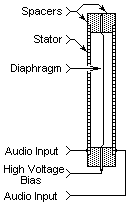HOW DO ELECTROSTATIC SPEAKERS WORK?
Unlike conventional speakers that use magnetic forces to move a relatively heavy cone, electrostatic speakers use high voltages to move an extremely thin, light diaphragm. High voltages produce an attractive force similar to magnetism. You may have discovered this by combing your hair on a dry day. The comb takes on a high voltage charge and you can feel it pull the hair on your arm or watch it pick up dust or small bits of paper.
Note that this charge is STATIC (it doesn't move). In an electrostatic loudspeaker (ESL), a small, high-voltage power supply puts a static charge on the speaker's diaphragm. Hence the name, electroSTATIC loudspeaker. This is also why the speaker must be plugged into the wall like any other electronic component. On either side of the speaker's diaphragm is a STATOR, an electrically conductive, acoustically-transparent grill. The amplifier is connected to both stators through a high-voltage step-up transformer.
The transformer is necessary to raise the voltage of your amplifier from a few tens of volts to the several thousand volts needed to drive the diaphragm. Music causes the amplifier to deliver varying amounts of electricity to the stators.
Like north and south magnetic forces, positive and negative electrostatic forces are attracted to each other, while similar polarities are repelled from each other. Music drives the amplifier to produce a positive voltage on one stator and a negative voltage on the other. These voltages alternate back and forth between positive and negative very rapidly to produce a tone. For example, "middle C" on a piano has a frequency of 256 Hz (Hertz). That means the polarity on the stators will alternate 256 times per second. The amplifier also alters the voltage as necessary to make the music a particular loudness.
Now, let's look at what is happening inside the speaker to make it produce sound. At a given moment in time, in response to the musical signal, let's say the front stator has a positive voltage. The rear one will be negative. Let's assume that the diaphragm has a negative voltage. Remember that the diaphragm's voltage is static and comes from the little power supply and does not change like the voltages do on the stators.
The negatively-charged diaphragm will be attracted to the positively-charged front stator because opposite charges attract. It will be repelled from the negatively-charged rear stator because like-charges repel. A moment later, the amplifier will reverse the voltage polarity on the stators, so the diaphragm will move the other way. As the diaphragm moves, it produces pressure waves in the air that we hear as music.
WHY USE ELECTROSTATIC LOUDSPEAKERS?
ESLs have several advantages over conventional magnetic speakers. These include better transient response, lower distortion, and absence of resonances. Here's why:
TRANSIENT RESPONSE
The moving part of a magnetic speaker is relatively massive. Its voice coil, suspension system, and cone or dome, add up to a lot of mass. The total weight of all of these parts is much more than the air that the speaker drives. Music consists mostly of transients (rapidly starting and stopping sounds). Because mass has inertia, the mass of magnetic speakers prevents them from responding quickly enough to follow the rapidly-changing musical wave-form with perfect precision.
The diaphragm of an ESL is much thinner than a human hair. Its mass is so small, that at audio frequencies, an ESL can be considered to be a massless speaker. As a result, it responds instantaneously to the music and can accurately and effortlessly reproduce perfect transients.
DISTORTION
The voice coil of a magnetic speaker only drives one point (the apex of the cone or the edge of a dome tweeter). Because cones and domes are not perfectly rigid, the driven surface flexes and distorts the sound. By contrast, an ESL's diaphragm is driven uniformly over its entire surface. There is no distortion of the surface to alter the character of the music.
RESONANCES
A massive magnetic speaker resonates at many frequencies. It behaves somewhat like a bell. Because these resonances are not present in the music, magnetic drivers "color" the sound. Also, because the "ringing" continues long after the original note has stopped, transient response is poor.
An ESL's diaphragm is swamped by the mass of the air in which it is immersed. Much like trying to ring a bell under water, the ESL simply cannot "ring." The result is the legendary purity and clarity of sound for which electrostatic speakers are justly famous.
